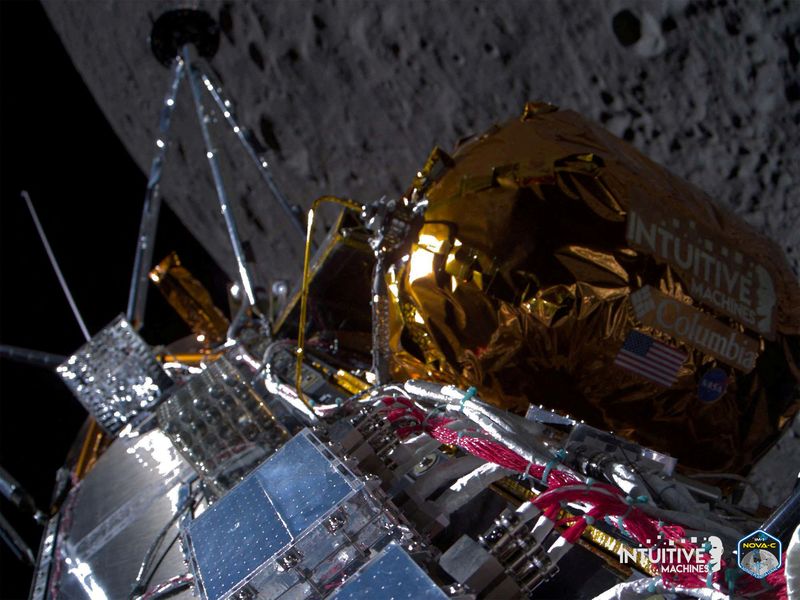By Steve Gorman and Joey Roulette
LOS ANGELES/WASHINGTON (Reuters) -Odysseus, the first U.S. spacecraft to land on the moon in half a century, neared a mission-ending slumber on Wednesday, six days after a lopsided touchdown that hindered its operation, though NASA and the company behind the vehicle cheered its performance as a success.
Despite persistent difficulties in communicating with the lander and keeping its solar batteries charged, NASA said it managed to extract some data from all six of its science payloads delivered by Odysseus, built and flown by Texas-based Intuitive Machines.
"We have conducted a very successful mission at this point," Intuitive Machines CEO Stephen Altemus told a joint news briefing with NASA officials on Wednesday. He said the flow of information retrieved from the spacecraft increased substantially after "sporadic" communications during the first few days.
Sue Lederer, a NASA project scientist, described the stream of data as going from "a cocktail-size straw to a boba-tea-size straw of data."
More precise estimates of how much research data and imagery were collected from NASA's experiments and a half-dozen commercial payloads, and how much were lost, would come later, officials said.
Still, Intuitive and NASA executives hailed the science achieved and the "soft" lunar landing itself - the first ever by a commercially manufactured and operated space vehicle - as a key breakthrough in a new chapter of lunar exploration.
Odysseus was also the first U.S. spacecraft to make a controlled descent to the lunar surface since NASA's final crewed Apollo mission to the moon in 1972.
And it was the first under NASA's Artemis program, which aims to send several more commercial robot landers to the moon on science scouting missions ahead of a planned return of astronauts to Earth's natural satellite later this decade.
NASA paid Intuitive $118 million to design, build and fly Odysseus, a project the company said privately cost about $100 million.
To date, space agencies of just four other countries have put a lander on the moon - the former Soviet Union, China, India and, just last month, Japan, whose own vehicle likewise tipped over sideways. The United States is the only country ever to have sent humans to the lunar surface.
Intuitive Machines' stock nearly tripled in the days following its Feb. 15 launch, but there was a steep selloff after the rough landing last week, with the shares falling a further 12.3% on Wednesday. The shares remain up about 18% since the launch.
REAWAKENING ATTEMPT PLANNED
Engineers planned to put Odysseus "to sleep" on Wednesday evening as the lander ended its sixth day on the moon, once solar power regeneration was no longer sufficient to keep it sending telemetry back to Earth, at around 8 p.m. EST (0100 GMT), Altemus said.
A company spokesperson, Josh Marshall, later told Reuters mission operators had decided instead to leave the spacecraft running a bit longer, until its batteries were drained, and letting the lander go dark on its own.
Altemus said flight controllers would seek to restart Odysseus in three weeks, after the sun rises again over the vehicle's landing site in the moon's south pole region.
NASA and Intuitive Machines had said before the mission's launch that its payloads should operate on the lunar surface for roughly seven days before lunar nightfall.
The six-legged Nova-C-class lander, shaped like a hexagonal cylinder and standing 13 feet (4 m) tall, was launched on Feb. 15 from NASA's Kennedy Space Center in Florida on a Falcon 9 rocket supplied by Elon Musk's SpaceX. It arrived in lunar orbit six days later.
The vehicle reached the lunar surface last Thursday after an 11th-hour navigational glitch and descent that ended with Odysseus catching one of its feet on the ground and landing in a sharply tilted position, immediately impeding its operations.
Intuitive Machines have said human error was to blame for the navigational issue. Flight readiness teams had neglected to manually unlock a safety switch before launch, preventing subsequent activation of the vehicle's laser-guided range finders and forcing flight engineers to hurriedly improvise an alternative during lunar orbit.
The last-minute work-around likely prevented a crash-landing but may have contributed to the vehicle landing askew, company officials said.
A newly released image on Wednesday showed the spacecraft as it was touching down on the surface, with its landing gear visibly damaged. Altemus said the spacecraft was moving faster than expected during final approach and skidded to a stop as it landed, ending up tilted at a 30-degree angle.
The company said that two of the spacecraft's communication antennae were knocked out of commission, and its solar panels were likewise facing the wrong direction, limiting the vehicle's ability to recharge its batteries.
Japan's space agency JAXA experienced a setback similar to Odysseus in January with its own SLIM moon lander, which ran out of power after tipping and leaving its solar panels at the wrong angle.
Earlier this week, however, JAXA reported that its lander had unexpectedly survived a freezing lunar night and re-established communication with Earth.
